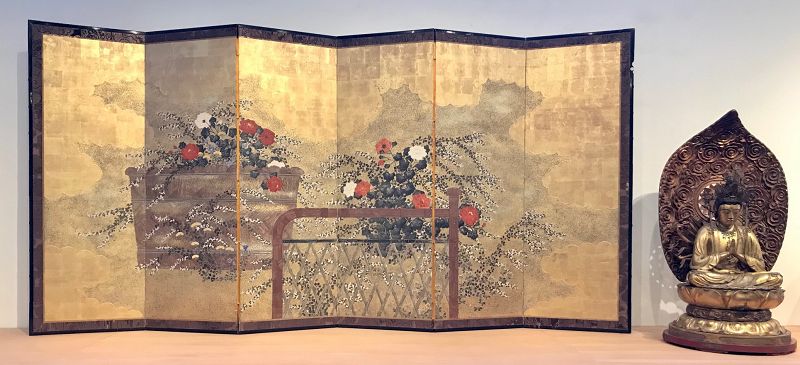Japanese 19th c. Lacquer Inro Signed Hasegawa Shigeyoshi
Japanese five section lacquer inro in the hiramaki-e technique. The low relief gilt lacquer adds depth throughout the landscape composition of pine forest, distant ocean, mountainous terrain, and the famous Uji bridge. The black ground lacquer also shows the use of nashiji gold flecks creating mist and cloud formation. The interior of the compartments are covered with the nashiji gold flecks, resembling a pear skin effect. The ojime bead is of sliver and gold in the form of a laughing face of Hotei. Signed Hasegawa Shigeyoshi with red pot seal.
Inro (seal basket) are small decorative containers that hang from the waist. They originate at the end of the 16th century and were worn by men to hold seals and herbal or other medicines. They were considered a particularly good way of keeping the contents sealed and fresh. By the 18th century, they became decorative accessories and were commissioned by the merchant class, provincial rulers and their samurai, and those that could afford them. Inro are made from very thin leather, wood or paper covered in decorative lacquer. They consist of separate sections stacked on top of each other, and are kept together by a cord loop that passes through a channel on each side and underneath the bottom section. The sections are held together when the cord is tightened by pulling it through a bead (ojime). The cord is then passed behind the waist sash so that the inro hangs freely from the waist. To prevent the inro from slipping through the obi, a small decorative toggle (netsuke) is attached to the end of the cord.
19th century Meiji period (1868-1912)
Dimensions: 3 1/4" x 2 2/8" x 3 3/8" H (without cord)
https://zentnercollection.com/product/japanese-19th-c-lacquer-inro-signed-hasegawa-shigeyoshi/


